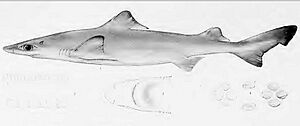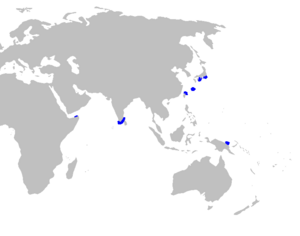Dwarf gulper shark facts for kids
Quick facts for kids Dwarf gulper shark |
|
|---|---|
 |
|
| Conservation status | |
| Scientific classification | |
| Genus: |
Centrophorus
|
| Species: |
atromarginatus
|
 |
|
| Range of dwarf gulper shark (in blue) | |
The dwarf gulper shark (Centrophorus atromarginatus) is a type of dogfish shark. It belongs to the family called Centrophoridae. You can find this shark in the Indo-West Pacific oceans. This includes places like the Gulf of Aden, Japan, Taiwan, and northern Papua New Guinea. These sharks live deep underwater, usually between 328 feet and 3,937 feet (100 to 1,200 meters) below the surface. They are known for living and finding food at these great depths.
Contents
About the Dwarf Gulper Shark
What Does a Dwarf Gulper Shark Look Like?
The dwarf gulper shark is a long, slender dogfish. It has two fins on its back called dorsal fins. Both of these fins have long, grooved spines. The second dorsal fin is a bit shorter than the first one.
The shark's color can be olive-grey, grey-brown, or sandy grey to brown on its back. Its belly is usually lighter. Adult sharks don't have clear markings. Young sharks might be lighter in color and have darker tips on their dorsal and tail fins.
How Big Do They Get?
The biggest dwarf gulper shark ever recorded was about 5 feet (150 cm) long. When baby gulper sharks are born, they are usually between 1 to 1.4 feet (30 to 42 cm) long. Scientists are still learning about how fast these sharks grow and when they become adults.
Why Are Gulper Sharks Important?
Squalene: A Special Compound from Sharks
Like other sharks in its group, the dwarf gulper shark has a lot of a substance called Squalene in its liver. Squalene is a useful chemical for human health. People fish for these sharks to get this squalene. It is then changed into another form called squalane, which is used in many products.
Using Shark Muscle for Health
While squalene is important, the meat of the dwarf gulper shark is not eaten much. This is because it can develop a strong ammonia smell as it gets older. However, scientists are looking into other ways to use shark muscle.
They can break down the proteins in shark muscle using special enzymes. This creates smaller pieces called peptides. Some of these peptides can help lower high blood pressure. This is good news because high blood pressure is a common health issue worldwide. By using different enzymes, scientists can make these helpful peptides. This means that parts of the shark that might have been wasted can now be used to create healthy food products.
Other Gulper Shark Species
The family Centrophoridae includes other types of gulper sharks, like the gulper shark (Centrophorus granulosus). This species was first identified in 1801. The name Centrophorus comes from Greek words meaning "thorn" and "to bear." This refers to the spines found on the dorsal fins of these sharks.
In the eastern Atlantic Ocean, gulper sharks are caught using different fishing methods. These include bottom trawls, hook and line, and pelagic trawls. Sometimes, they are caught by accident when fishermen are trying to catch other fish.
New Discoveries About Gulper Sharks
Recently, a small gulper shark was found far north in the Norwegian Sea. This was the farthest north this type of shark had been seen in the eastern North Atlantic Ocean. Scientists studied its features and its DNA. They found that it was very similar to a species found in Australia called Centrophorus zeehaani. DNA tests even suggested that C. uyato and C. zeehaani might be the same species.
Scientists have also updated how they classify species in the Centrophorus group. Now, four species are recognized in the eastern North Atlantic Ocean:
- C. granulosus
- The lowfin gulper shark (Centrophorus lusitanicus)
- The leafscale gulper shark (Centrophorus squamosus)
- The little gulper shark (Centrophorus uyato)
The Centrophorus uyato can grow up to 110 cm (about 3.6 feet) long. Males of this species become adults when they reach about 80 cm (about 2.6 feet) in length. This new discovery helps scientists understand more about where these sharks live and how different species are related.
Images for kids




